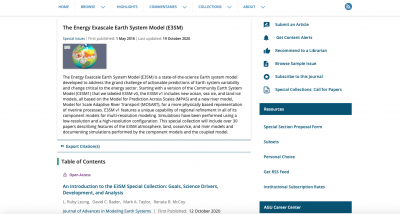An Introduction to the AGU E3SM Special Collection
Earth system models are important tools for predicting future changes in the Earth system. The Energy Exascale Earth System Model (E3SM) project aims to improve predictions of Earth system variability and change. This introduction paper for the AGU E3SM Special Collection provides an overview of the E3SM project and its goals of addressing science questions centered on the Earth’s water cycle, biogeochemistry, and cryosphere systems, as well as integrating leading-edge computational advances into model development.
Based on the Community Earth System Model v1, E3SM v1 includes many innovations in its component models that are highlighted in the introduction paper. It presents a brief history of E3SM development, including the key features of E3SM v1 released in 2018, highlights the advances and challenges in modeling water cycle and biogeochemistry, and summarizes the E3SM v1 model’s skill relative to Coupled Model Intercomparison Project Phase 5 models. E3SM possesses a unique capacity to produce high-resolution simulations through regional refinement that lays the foundation for addressing the vulnerability of the energy sector to earth system variability and change.
The E3SM project was conceived from the confluence of energy mission needs and disruptive changes occurring in scientific computing technology. Developed as a state-of-the-science Earth system modeling project, E3SM aims to optimize the use of Department of Energy (DOE) resources to meet the scientific needs of DOE. The long-term goal of the project is to address the grand challenge of generating actionable predictions of Earth system variability and change, with an emphasis on the most critical scientific questions facing the nation and DOE. This introduction to the AGU E3SM Special Collection describes the E3SM science and computational goals and provides a brief history of the development of E3SM v1. This includes a summary of the model’s features and the comprehensive infrastructure for code management, along with its development, testing, analysis, and computational performance. The paper also highlights the advances and challenges in modeling the water cycle and biogeochemistry of the Earth system as well as the characteristics of the coupled model simulations used to address the water cycle and biogeochemistry science questions.

